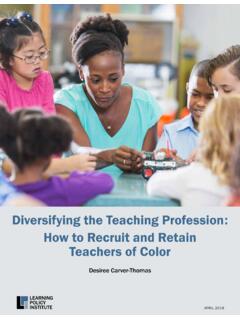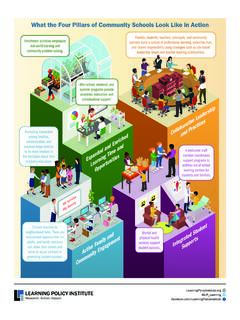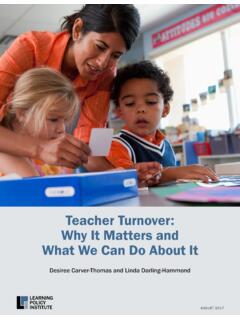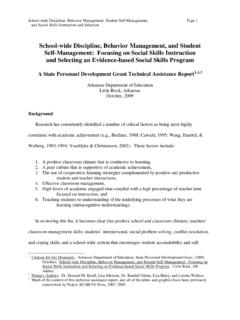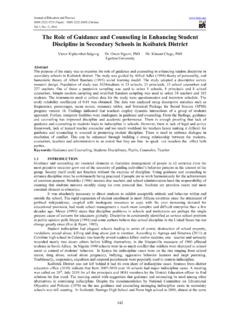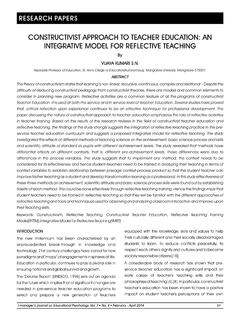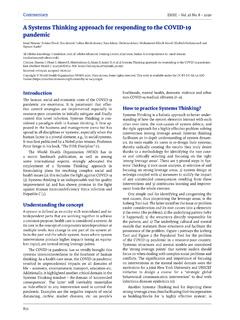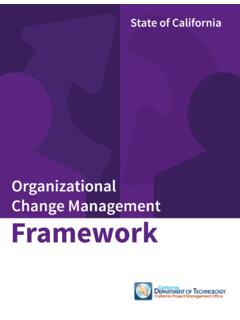Transcription of Educating the Whole Child: Improving School Climate to ...
1 Linda Darling-Hammond and Channa M. Cook-HarveyEducating the Whole child : Improving School Climate to Support Student SuccessSEPTEMBER 2018 Educating the Whole child : Improving School Climate to Support Student SuccessLinda Darling-Hammond and Channa M. Cook-Harveyii LEARNING POLICY INSTITUTE | Educating THE Whole CHILDA cknowledgmentsThe authors would like to thank Castle Redmond and Jennifer Chheang at the California Endowment for their thoughtful guidance and input into this report. We also benefited from the feedback of a number of California educators, researchers, community organization leaders, and advocates, including Teiahsha Bankhead, Restorative Justice for Oakland Youth; Joseph Bishop, Center for the Transformation of Schools at UCLA; Dwight Bonds, California Association of African-American Superintendents and Administrators; Susan Bonilla, Council for a Strong America; Raymond Colmenar, The California Endowment; Sean Darling-Hammond, University of California, Berkeley; Joyce Dorado, University of California, San Francisco; Laura Faer, Public Counsel Law Center; Sophie Fanelli, Stuart Foundation; Liz Guillen, Public Advocates; Jessica Gunderson, Partnership for Children Thomas Hanson, WestEd; Heather Hough, Policy Analysis for California Education; Taryn Ishida, Californians for Justice.
2 Debbie Lee, Futures Without Violence; Sergio Luna, PICO California; Brent Malicote, Sacramento County Office of Education; Kim Mecum, Fresno Unified School District; Mary Perry, California State PTA; Glen Price, California Department of Education; Ryan Smith, The Education Trust West; Elisha Smith Arrillaga, The Education Trust West; Brad Strong, Children Now; Sylvia Torres-Guill n, ACLU of Southern California; and David Washburn, EdSource. We appreciate LPI colleagues Lisa Flook, Roberta Furger, and Hanna Melnick for providing background research and input to this report, and Charlie Thompson for her expert help with references and citations. In addition, thanks are due to Aaron Reeves and Gretchen Wright for their design and editing contributions to this project, and to Lisa Gonzales for overseeing the editorial and production processes.
3 This document draws upon the article Implications for Practice of the Science of Learning and Development by Linda Darling-Hammond, Lisa Flook, Channa Cook-Harvey, Brigid Barron, and David Osher, and on two articles, recently published in Applied Developmental Science, from the Science of Learning and Development initiative on which it builds: Cantor, P., Osher, D., Berg, J., Steyer, L., & Rose, T. (2018). Malleability, plasticity, and individuality: How children learn and develop in context and Osher, D., Cantor, P., Berg, J., Steyer, L., Rose, T. (2018). Drivers of human development: How relationships and context shape learning and development. We are grateful to The California Endowment for its funding of this report. Funding for this area of LPI s work is also provided by the Chan Zuckerberg Initiative, the S. D. Bechtel, Jr. Foundation, and the Stuart Foundation.
4 Core operating support for the Learning Policy Institute is provided by the Sandler Foundation, the William and Flora Hewlett Foundation, and the Ford ReviewersThis report benefited from the insights and expertise of two external reviewers: Mark Greenberg, Bennett Chair of Prevention Research at Penn State University and Founding Director of the Edna Bennett Pierce Prevention Research Center; and Ming-Te Wang, Associate Professor of Psychology and Education and Research Scientist at Learning Research and Development Center. We thank them for the care and attention they gave the report; any shortcomings remain our suggested citation for this report is: Darling-Hammond, L., & Cook-Harvey, C. M. (2018). Educating the Whole child : Improving School Climate to support student success. Palo Alto, CA: Learning Policy report can be found online at photo Drew work is licensed under the Creative Commons Attribution-NonCommercial International License.
5 To view a copy of this license, visit POLICY INSTITUTE | Educating THE Whole child iiiTable of ContentsExecutive ..1 The Need for a Whole child approach to Education ..1 The Shifts That Are Needed ..2 Key Lessons From the Sciences of Learning and Development ..41. Development is malleable ..42. Variability in human development is the norm, not the exception ..43. Human relationships are the essential ingredient that catalyzes healthy development and learning ..54. Adversity affects learning and the way schools respond matters ..65. Learning is social, emotional, and academic ..76. Children actively construct knowledge based on their experiences, relationships, and social contexts ..8 Implications for Schools: The Critical Importance of a Whole child Framework and a Positive School Climate ..9 Why a Whole child approach Is Essential.
6 10 School Climate and Culture: The Foundation for Development ..11 Strategies for Developing Productive School Environments ..14 Building Positive Classroom and School Environments ..15 Shaping Positive Student Behaviors ..22 Providing Supports for Student Motivation and Learning ..27 Creating Multi-Tiered Systems of Support to Address Student Needs ..32 Policy Strategies ..36 Developing and Assessing Positive Learning Environments ..37 Using School Climate Data to Diagnose School Needs ..38 Helping Schools Improve Climate and Culture ..40 Reducing Rates of Exclusionary Discipline ..42 Providing a Multi-Tiered System of Student Support ..44 Investing in Educator Preparation and Development ..45iv LEARNING POLICY INSTITUTE | Educating THE Whole CHILDR ecommendations ..50 Recommendation #1: Focus the System on Developmental Supports for Young People.
7 50 Recommendation #2: Design Schools to Provide Settings for Healthy Development ..51 Recommendation #3: Ensure Educator Learning for Developmentally Supportive Education ..52 Conclusion ..53 Endnotes ..54 About the Authors ..68 List of Figures and TablesFigure 1: The Whole child Ecosystem ..2 Figure 2: A Framework for Whole child Education ..14 Figure 3: Sample NYC Department of Education School Quality Snapshot Summary ..40 Figure 4: California Principals Report Wanting More Professional Development ..48 Table 1: The National School Climate Council s 13 Dimensions of School Climate ..12 LEARNING POLICY INSTITUTE | Educating THE Whole child vExecutive SummaryNew knowledge about human development from neuroscience and the sciences of learning and development demonstrates that effective learning depends on secure attachments; affirming relationships; rich, hands-on learning experiences; and explicit integration of social, emotional, and academic skills.
8 A positive School environment supports students growth across all the developmental pathways physical, psychological, cognitive, social, and emotional while it reduces stress and anxiety that create biological impediments to learning. Such an environment takes a Whole child approach to education, seeking to address the distinctive strengths, needs, and interests of students as they engage in learning. Given that emotions and relationships strongly influence learning and that these are the byproducts of how students are treated at School , as well as at home and in their communities a positive School Climate is at the core of a successful educational experience. School Climate creates the physiological and psychological conditions for productive learning. Without secure relationships and supports for development, student engagement and learning are undermined.
9 In this paper, we examine how schools can use effective, research-based practices to create settings in which students healthy growth and development are central to the design of classrooms and the School as a Whole . We describe key findings from the sciences of learning and development, the School conditions and practices that should derive from this science, and the policy strategies that could support these conditions and practices on a wide scale. Key Lessons From the Science of Learning and DevelopmentIn recent years, a great deal has been learned about how biology and environment interact to produce human learning and development. A summary of the research from neuroscience, developmental science, and the learning sciences points to the following foundational principles: 1. Development is malleable. The brain never stops growing and changing in response to experiences and relationships.
10 The nature of these experiences and relationships matters greatly to the growth of the brain and the development of brain architecture and effective learning are developed by the presence of warm, consistent relationships; empathetic back-and-forth communications; and modeling of productive behaviors. The brain s capacity develops most fully when children and youth feel emotionally and physically safe; when they feel connected, supported, engaged, and challenged; and when they have robust opportunities to learn with rich materials and experiences that allow them to inquire into the world around them and equally robust support for LEARNING POLICY INSTITUTE | Educating THE Whole CHILD2. Variability in human development is the norm, not the exception. The pace and profile of each child s development is unique. Because each child s experiences create a unique trajectory for growth, there are multiple pathways and no one best pathway to healthy learning and development.
